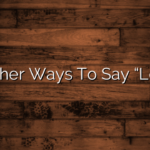In various social and professional settings, individuals often experience a range of emotions that are challenging to articulate. One such emotion is discomfort, which encompasses feelings of unease, displeasure, or awkwardness. While the term ‘uncomfortable’ is commonly used to express this state, there exist numerous other ways to convey this complex emotional experience.
This article aims to explore alternative expressions for ‘uncomfortable,’ offering readers a broader vocabulary to better describe their feelings accurately.
To illustrate the importance of employing diverse language when discussing discomfort, consider the following scenario: imagine a job interview where an applicant feels ill at ease due to the questions posed by the interviewer. Instead of merely labeling this sensation as uncomfortable, an individual may opt for more precise terms such as feeling uneasy, off-kilter, or even displeased. By utilizing these alternate expressions, individuals can effectively communicate their emotional state with greater clarity and nuance.
Through examining different synonyms for ‘uncomfortable,’ this article will equip readers with a comprehensive range of linguistic tools necessary for articulating their feelings in various contexts.
Key Takeaways
- Alternative expressions for ‘uncomfortable’ can provide individuals with a broader vocabulary to articulate their feelings of discomfort in social and professional settings.
- Uneasiness is a sensation that arises in unfamiliar or unpredictable situations and can be associated with awkwardness, uncertainty in behavior or interaction, and social anxiety.
- Nonverbal cues such as excessive sighing, eye rolling, and crossed arms can be indicators of displeasure and discomfort.
- Understanding and acknowledging the discomfort behind off-kilter behavior can foster empathy and create an inclusive environment.
Feeling Uneasy
The sensation of uneasiness can often arise when one is faced with an unfamiliar or unpredictable situation. This feeling is commonly experienced in awkward situations, where individuals may feel unsure about how to behave or interact with others. It can also be associated with social anxiety, which involves a fear of being judged or evaluated by others.
People experiencing uneasiness may exhibit physical symptoms such as increased heart rate, sweating, or trembling. Additionally, they may struggle to maintain eye contact, speak confidently, or engage in small talk. The discomfort felt in these situations can vary in intensity and duration depending on the individual and their personal experiences.
Understanding the factors that contribute to feelings of uneasiness can help individuals develop coping strategies and navigate these challenging circumstances more effectively.
Displeased
Displeasure can be conveyed through various means, such as facial expressions or body language, with a study showing that approximately 55% of communication is nonverbal. When feeling frustrated or annoyed, individuals may exhibit specific behaviors that communicate their discomfort:
-
Excessive sighing: This audible expression of frustration indicates dissatisfaction and impatience.
-
Eye rolling: Rolling one’s eyes conveys annoyance and disdain towards a person or situation.
-
Frowning: A furrowed brow and downturned mouth express displeasure and discontent.
-
Tapping fingers or feet: This repetitive motion reflects impatience and irritation.
-
Crossed arms: Crossing arms over the chest creates a physical barrier, signaling defensiveness and discomfort.
Understanding these nonverbal cues can help interpret others’ emotions accurately. However, it is essential to consider individual differences in expressing displeasure as cultural backgrounds and personal experiences may influence how discomfort is conveyed.
Off-Kilter
Off-kilter behavior can be observed as a manifestation of unease or discomfort in individuals. It is characterized by an individual’s awkwardness or deviation from expected social norms, which can stem from various factors such as social anxiety. Awkward situations often trigger feelings of discomfort, leading to off-kilter behavior as individuals struggle to navigate these challenging interactions.
In such instances, people may exhibit unusual speech patterns, body language, or engage in socially inappropriate actions. Off-kilter behavior can serve as a coping mechanism for those experiencing unease in social settings, allowing them to establish distance and protect themselves from perceived threats. Understanding and acknowledging the underlying discomfort behind off-kilter behavior can foster empathy and create an inclusive environment that supports the well-being of individuals facing social anxiety.
Awkward
Awkwardness can be likened to a dance partner who repeatedly steps on your toes, interrupting the flow of movement and causing an uneasy imbalance in social interactions.
Socially awkward situations often arise when individuals struggle to navigate the unwritten rules of social behavior, resulting in discomfort and unease.
These situations may involve inappropriate comments, lack of eye contact, or difficulty initiating or sustaining conversations.
In dealing with uncomfortable silence, individuals may resort to filler words or nervous laughter in an attempt to fill the void. However, these attempts often exacerbate the awkwardness rather than alleviate it.
Finding strategies to handle such situations, such as active listening and non-verbal cues, can help individuals overcome feelings of awkwardness and create more comfortable social interactions.
Ill at Ease
Ill at Ease, a state of discomfort or unease, can be experienced in social situations when individuals struggle to navigate the unwritten rules of social behavior. It is a feeling characterized by an unsteady and anxious mindset.
People who are ill at ease may find themselves unsure of how to act or what to say, leading to self-consciousness and a heightened sense of discomfort. This state can arise in various contexts, such as formal events, unfamiliar environments, or interactions with unfamiliar people.
The experience of feeling ill at ease can hinder one’s ability to fully engage in social interactions and may result in avoiding certain situations altogether. Understanding and addressing this discomfort is important for individuals seeking to improve their social skills and overall well-being.
Frequently Asked Questions
How can I overcome feeling uneasy in social situations?
Overcoming social anxiety and building confidence in social situations can be achieved by implementing strategies such as gradual exposure therapy, cognitive restructuring, and practicing assertiveness skills. These techniques help individuals develop self-assurance and navigate uncomfortable social interactions effectively.
Are there any specific strategies to manage feelings of displeasure in a professional setting?
Strategies for managing discomfort in a professional setting involve coping with uneasiness in social situations. Effective approaches include practicing self-awareness, developing communication skills, seeking support from colleagues, and utilizing stress-management techniques to alleviate displeasure.
What are some common causes of feeling off-kilter and how can I address them?
Feeling off-kilter can stem from various causes, such as anxiety or insecurity. To address these feelings, one can engage in self-reflection, seek support from others, and employ coping strategies to overcome insecurities and regain a sense of balance.
Is there any advice for navigating awkward moments during conversations?
To navigate awkward moments during conversations, individuals can employ effective communication techniques and build emotional intelligence. These strategies facilitate understanding, empathy, and adaptability, helping to diffuse tension and maintain harmony in social interactions.
Are there any techniques to help alleviate the discomfort of feeling ill at ease in unfamiliar environments?
Overcoming social anxiety and adapting to new environments can be achieved through various strategies. Techniques such as exposure therapy, cognitive restructuring, and social skills training have been found effective in alleviating discomfort and promoting a sense of ease in unfamiliar settings.
Conclusion
In conclusion, there are various alternative expressions to convey the idea of discomfort. These include feeling uneasy, displeased, off-kilter, awkward, and ill at ease.
Each synonym captures a different aspect of the state of being uncomfortable, allowing for a more nuanced understanding and expression.
Just as a ship navigating through treacherous waters must carefully adjust its course to avoid danger, individuals can navigate their own emotions by exploring these different ways to articulate their discomfort.
By doing so, they can better communicate their feelings and foster healthier relationships.



